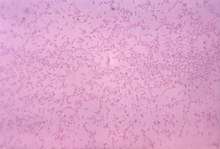Pasteurella
Pasteurella is a genus of Gram-negative, facultatively anaerobic bacteria.[1][2] Pasteurella species are nonmotile and pleomorphic, and often exhibit bipolar staining ("safety pin" appearance). Most species are catalase- and oxidase-positive.[3] The genus is named after the French chemist and microbiologist, Louis Pasteur, who first identified the bacteria now known as Pasteurella multocida as the agent of chicken cholera.
| Pasteurella | |
|---|---|
 | |
| Gram-stained photomicrograph depicting numerous Pasteurella multocida bacteria | |
| Scientific classification | |
| Kingdom: | |
| Phylum: | |
| Class: | |
| Order: | |
| Family: | |
| Genus: | Pasteurella Trevisan 1887 |
| Species | |
|
P. aerogenes | |
Pathogenesis
Many Pasteurella species are zoonotic pathogens, and humans can acquire an infection from domestic animal bites.[4][5] In cattle, sheep, and birds, Pasteurella species can cause a life-threatening pneumonia; in cats and dogs, however, Pasteurella is not a cause of disease, and constitutes part of the normal flora of the nose and mouth.[6] Pasteurella haemolytica is a species that infects mainly cattle and horses: P. multocida is the most frequent causative agent in human Pasteurella infection.[7] Common symptoms of pasteurellosis in humans include swelling, cellulitis, and bloody drainage at the site of the wound. Infection may progress to nearby joints, where it can cause further swelling, arthritis, and abscesses.[6]
Pasteurella spp. are generally susceptible to chloramphenicol, the penicillins, tetracycline, and the macrolides.[6]
The common occurrence of the bacteria is a reason to be medically proactive and defensive (antibacterial treatments are often necessary) if a bite occurs.[8]
In animals
P. multocida is also known to cause morbidity and mortality in rabbits. The predominant syndrome is upper respiratory disease. P. multocida can be endemic among rabbit colonies and is often transmitted through nasal secretions. P. multocida can survive several days in water or moist areas.[9] Pasturella can be transmitted through the bite of a dog.[10]
Antibiotic sensitivity
P. multocida is highly sensitive to enrofloxacin, oxytetracycline, chloramphinicol, and ampicillin.[11]
References
- "Pasteurella". List of Prokaryotic Names with Standing in Nomenclature. Retrieved 2006-04-06.
- Kuhnert P; Christensen H, eds. (2008). Pasteurellaceae: Biology, Genomics and Molecular Aspects. Caister Academic Press. ISBN 978-1-904455-34-9.
- Health Protection Agency (2007). Identification of Pasteurella species and morphologically similar bacteria (.pdf) Archived 2009-09-22 at the Wayback Machine. National Standard Method BSOP ID 13 Issue 2.1.
- "Pasteurella". Introduction To Clinical Microbiology. Archived from the original on 2006-01-16. Retrieved 2006-04-06.
- Mark A Marinella, MD. "Community-Acquired Pneumonia Due to Pasteurella multocida" (PDF).
- Collins, Frank M. (1996-01-01). Baron, Samuel (ed.). Pasteurella, Yersinia, and Francisella (4th ed.). Galveston (TX): University of Texas Medical Branch at Galveston. ISBN 0963117211. PMID 21413268.
- Collins FM (1996). Barron S; et al. (eds.). Pasteurella, Yersinia, and Francisella. In: Baron's Medical Microbiology (4th ed.). Univ of Texas Medical Branch. ISBN 0-9631172-1-1. (via NCBI Bookshelf).
- "In vitro Antimicrobial Susceptibility of Pasteurella Mutocida" (PDF). Pakistan Journal of Agriculture, Agriculture Engineering and Veterinary Sciences.
- Barbara Deeb, DVM, MS Assistant Professor Dept. of Comparative Medicine University of Washington. "Pasteurella multocida Infection in Rabbits".CS1 maint: multiple names: authors list (link)
- "Human Rabies Prevention, United States, Recommendations of the Advisory Committee on Immunization Practices" (PDF). Centers for Disease Control and Prevention, Morbidity and Mortality Weekly Report. 2008. p. 2. Retrieved April 25, 2017.

- "Pets and Pasteurella Infections". healthy children.org. June 27, 2012. Retrieved July 18, 2012.
External links
- Man 'first rabbit flu victim' - BBC News
- "Your Bunny Probably Has It - Pasteurella" by Astrid M. Kruse, DVM